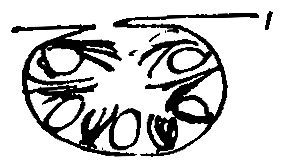From William Henry Harvey 3 January 1857
Trin. Coll. Dublin
Jan. 3d. 1857.
My dear Sir
Your letter arrived during my absence in the Country at Xmas, and I only received it on my return to town this evening. 1 In reply to your query respecting the sexes of Algæ—the great majority with whose male & female organs I am acquainted are Monoecious in the Linnæan sense—but the different sexes are frequently placed in juxta position, within the walls of a common receptacle,—much in the same way as those of Euphorbia are brought within an involucre. In most of the Fucoideæ both spores & antheridia are found in each little cyst of the receptacle
 — But in some Cystoseiræ & Sargassa they occur in different cysts.— And other genera are truly Diœcious, such as Splachnidium, Durvillœa, Sarcophycus, Hormosira, & some others—& many Sargassa.— Cutleria multifida is a good example of a clearly diœcious plant.
— But in some Cystoseiræ & Sargassa they occur in different cysts.— And other genera are truly Diœcious, such as Splachnidium, Durvillœa, Sarcophycus, Hormosira, & some others—& many Sargassa.— Cutleria multifida is a good example of a clearly diœcious plant.
I do not remember any invariably Diœcious Rhodosperm (or Floridea)—except perhaps some of the Callithamnia may be so. They are at least polygamous. You are, of course, aware of the double female system of the Florideæ—which is invariably dioecious—but I think the male is common to either kind of female. It is perhaps more common to find antheridia on individuals bearing “tetraspores”, than on those that bear “spores”.—
I am not acquainted with any instance of true hermaphroditism, such as occurs in flowers. The nearest approach to such is found in the Fuci, & in certain Dictyoteæ & Chordarieæ—
No doubt you are familiar with Thurets admirable papers on the Sexes of the Algæ, in various Vols. of An. des Sc. Nat.2 If not, you should look to them.
I am obliged by your kind congratulations on my return home.3 I hope we may see you at the Dublin meeting of Brit. Assn. this year, & that Hooker will be here too.4
Believe me | my dear Sir | very truly yours | W. H. Harvey.
CD annotations
Footnotes
Bibliography
Natural selection: Charles Darwin’s Natural selection: being the second part of his big species book written from 1856 to 1858. Edited by R. C. Stauffer. Cambridge: Cambridge University Press. 1975.
Thuret, Gustave Adolphe. 1854–5. Recherches sur la fecondation des Fucacées, suivies d’observations sur les anthéridies des Algues. Annales des sciences naturelles (botanique) 4th ser. 2: 197–214; 3: 5–28.
Summary
Sexes of algae.
Letter details
- Letter no.
- DCP-LETT-2035
- From
- William Henry Harvey
- To
- Charles Robert Darwin
- Sent from
- Trinity College, Dublin
- Source of text
- DAR 166: 115
- Physical description
- ALS 4pp †
Please cite as
Darwin Correspondence Project, “Letter no. 2035,” accessed on 19 April 2024, https://www.darwinproject.ac.uk/letter/?docId=letters/DCP-LETT-2035.xml
Also published in The Correspondence of Charles Darwin, vol. 6


